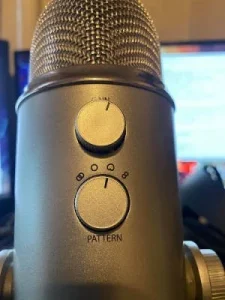Background noise is a big problem with the Blue Yeti for some people who use their USB mic for recording or live streaming. Whether you are recording voice, music recording, making youtube videos or podcasting, unwanted noises can be an issue that takes up time in post-production. In this blog post I am going to give you 5 steps on how to prevent the ambient sounds from your Blue Yeti and help improve your sound quality. If your Blue Yeti sounds bad, I’m sure you will find this post helpful.
Why is my mic picking up ambient noise?
Your Blue Yeti mic could be picking up ambient sounds because it is too close to a speaker, or because there are other devices on your computer that have similar frequencies.
One way to fix this problem is by moving the USB microphone away from any speakers (or turning them off) and checking for anything else with sounds in the same frequency range as your mic such as your laptop’s fan or pc, and air conditioners.
Another reason could be due to your gain knob settings. If you are not recording with an input level that is high enough, the mic will pick up ambient noise in the room.
If your gain is too high, you may also pick up noises from outside your home or office. To take full advantage of the Blue Yeti’s sound quality, you need to stop ambient sounds from your mic as much as possible.
Also, it could be because your Blue Yeti sound input is plugged into a separate audio interface hub instead of the USB port, which may introduce noise from other sources.
1) Best Settings for Blue Yeti: Adjust mic sensitivity
To adjust Blue Yeti mic sensitivity settings, follow these steps:
-Open the Blue Yeti dashboard by going to Settings > Microphone Settings
-Scroll down and select the blue mic you want to change. You can access individual mic settings by clicking on one of them in order (one through four)
The noise gate should be set at 0 dB, which is the default setting.
-Select the Blue Yeti to adjust gain sensitivity for and then drag the slider at the bottom (red, green)
To increase or decrease noise, you will need to change the gain number by increments of 0.01 dB. For example: if I wanted a more sensitive microphone, I would put the slider at -0.01 dB, if I still want some room audio in my recording then I would put the gain slider around 0.09 dB.
Also if you adjust your Blue Yeti mic positioning so that the mic is nearer the sound source, then you will be able to work with less gain, and so have less unwanted room sounds in your overall sound. If your USB ports are near your computer fan, then use a powered USB hub with a long cable, to allow you to have the mic far away in a quiet place from your recording devices or laptop. Also check that your USB cable has a good connection.
If the sounds are coming from outside, heavy curtains can help muffle the sound a little bit.
2) Use the correct polar pattern settings
With the Blue Yeti, you should also check your polar pattern settings because this will determine how much background noise you’ll be able to capture. On the Blue Yeti settings, there are four modes that determine the pickup patterns.
If you only want to capture the sounds directly in front of your microphone, you should set the polar pattern to Cardioid. This will be the main setting to use if you want to do voice recording. If you want to capture audio within the room in front and behind your mic, then choose Omnidirectional. If you want to record sound from all sides of your mic, then choose Bidirectional. These two settings could be useful to record musical instruments or a band.
The most sensitive gain setting with the least background sounds will be Cardioid.

3) Pop filter to reduce noise
You can also use a pop filter to reduce unwanted sounds. A pop shield is a piece of cloth which covers the microphone to help prevent “popping” P’s and T’s, which can happen when you speak too close to it. It can help get rid of sibilant sounds and can also help reduce other stuff in the room, such as fans etc.
4) Use a noise gate app or DAW plugin
Another way to have less noise, it to use a noise gate which will mute any sound below a certain level. A noise gate works by sensing the level of other sounds in a room, and only opens up again when there is no sound present.
It can also be very effective to use an app or plugin that records to disk instead of streaming live. That way you don’t have any sounds affecting your audio quality as it’s being recorded.
There are many free ones, paid and well known DAW’s like FL Studio which have their own plugin for this purpose. Others such as Audacity and Reaper also have similar plugins.
Some people prefer an app to a DAW, such as Noise Gate or Acoustica which both cost around $40-50 on PC. There are many other apps and free programs available for Mac users too.
As the Blue Yeti uses a USB connection, it’s not so practical to use a hardware-based noise gate pedal, so I would advise just doing it in software.
5) Active noise cancellation
Another option is active noise cancellation software which uses the mic to pick up ambient noise, and then plays back an opposite frequency as the sound which cancels out the noise.
This is often used for air travel or other noisy environments where it’s important to have crystal-clear audio without background sounds interfering.
Active cancellation also works great in pairs – one person can wear a microphone while their co-worker wears a speaker which is playing the opposite frequency.
This method also works well for musicians, allowing them to hear themselves and others without other sounds interfering with the sound.
Active cancellation can be expensive though – typically costing in excess of $200 per pair.
Conclusion
Background noises can be a huge problem for people who record podcasts or have to do voiceovers. Fortunately, the Blue Yeti microphone has some features that help you remove sound in the background and make your recording sound much better. If you want to learn more about how this mic works, check out my Blue Yeti review post where I talk all about its strengths and weaknesses so that you know if it’s right for what you need!

Leave a Reply